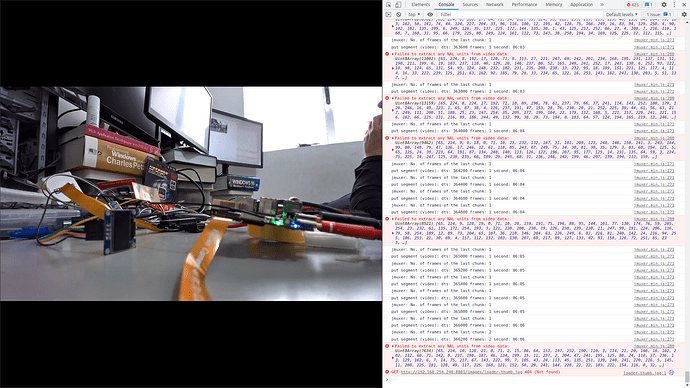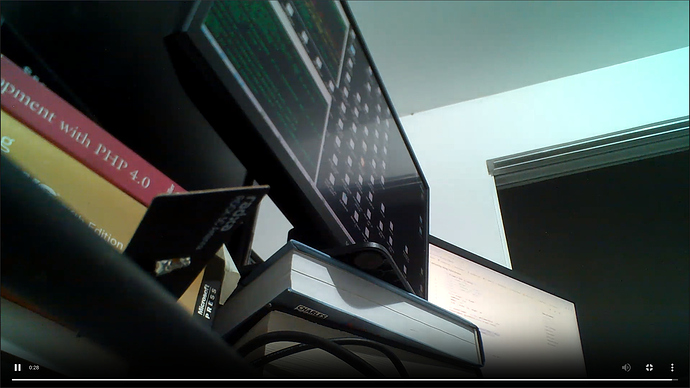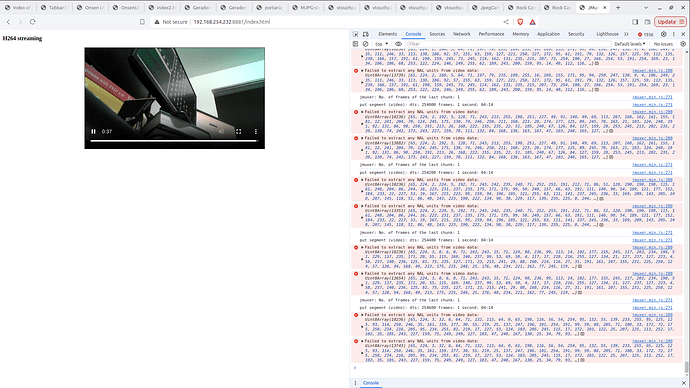Just for the sake of information, and until i find out how to disable those advanced encoding features i tried a new player with better results, and good latency but still lots of artifacts.
BTW, these flags seem not available anymore:
-wpredp 0
-tune zerolatency
I want to try this one (https://videojs.com/) but i haven’t found a way to send/receive a websocket message that will start pushing the stream on my ws server.
If anyone has experience with the videojs and can point out how to use it with websocket i would appreciate it.
Here is the script i use for the WSAvcPlayer that works:
<!DOCTYPE html>
<html>
<head>
<title>h264-live-player web client demo</title>
</head>
<body>
<p id='frame_buffer'></p>
<br />
<canvas id='cam' style="width:300px; height:200px;">
<!-- provide WSAvcPlayer -->
<script type="text/javascript" src="WSAvcPlayer.js">
;
</script>
<script type="text/javascript">
var canvas = document.getElementById('cam')
var fb = document.getElementById('frame_buffer')
// Create h264 player
var wsavc = new WSAvcPlayer(canvas, "webgl", 1, 35);
//expose instance for button callbacks
window.wsavc = wsavc;
var uri = window.location.protocol.replace(/http/, 'ws') + '//' + window.location.hostname + ':8080'
console.log('uri', uri);
var result = wsavc.connect(uri);
wsavc.on('disconnected', () => console.log('WS Disconnected'))
wsavc.on('connected', () => wsavc.send('*play'))
wsavc.on('frame_shift', (fbl) => {
fb.innerText = 'fl: ' + fbl
})
wsavc.on('initalized', (payload) => {
console.log('Initialized', payload)
})
wsavc.on('stream_active', active => console.log('Stream is ', active ? 'active' : 'offline'))
wsavc.on('custom_event_from_server', event => console.log('got event from server', event))
</script>
</body>
</html>
Here is the videojs script that needs to be fixed to decode and display the stream.
<!DOCTYPE html>
<html>
<head>
<meta charset='utf-8'>
<link href="video-js.min.css" rel="stylesheet">
<script src="video.min.js"></script>
<script src="sockjs.min.js"></script>
<style>
/* change player background color */
#myVideo {
background-color: #1a535c;
}
</style>
</head>
<body>
<video id="myVideo" playsinline class="video-js vjs-default-skin"></video>
<script>
/* eslint-disable */
var options = {
controls: true,
width: 320,
height: 240,
fluid: false,
bigPlayButton: false,
controlBar: {
volumePanel: false
}
};
// apply some workarounds for opera browser
// applyVideoWorkaround();
var player = videojs('myVideo', options, function() {
// print version information at startup
var msg = 'Using video.js ' + videojs.VERSION;
videojs.log(msg);
// connect to websocket server
var wsUri = window.location.protocol.replace(/http/, 'ws') + '//' + window.location.hostname + ':8080'
console.log('connecting to websocket: ' + wsUri);
var ws = new WebSocket(wsUri)
ws.binaryType = 'arraybuffer'
ws.onopen = function(e) {
ws.send('*play');
ws.binaryType = 'arraybuffer'
console.log('Client connected')
}
ws.onmessage = function(msg) {
// decode stream
console.log('msg received')
// HOWTO
// window.player.decode(new Uint8Array(msg.data));
//
}
ws.onclose = function(e) {
console.log('Client disconnected')
}
});
// error handling
player.on('deviceError', function() {
console.warn('device error:', player.deviceErrorCode);
});
player.on('error', function(element, error) {
console.error(error);
});
// user clicked the record button and started recording
player.on('startRecord', function() {
console.log('started recording!');
});
// user completed recording and stream is available
player.on('finishRecord', function() {
// the blob object contains the recorded data that
// can be downloaded by the user, stored on server etc.
console.log('finished recording: ', player.recordedData);
});
</script>
</body>
</html>






